
History Section
|

The History Section
La Section d'l'Histouaithe
Catching the Shadow
An Illustrated Talk on the Sundials of Jersey
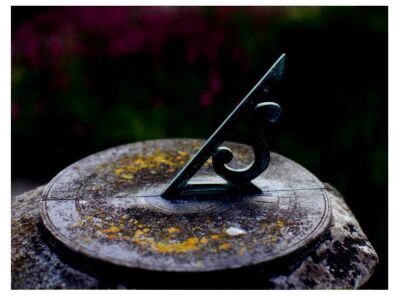
Given by David Levitt
In the Members' Room of the Société Jersiaise
On 29 November 2001
Introduction
I hope today to tell you something interesting about a subject with which you are all familiar. Sundials, for most of us, are on the fringes of our understanding. They are usually regarded as objects of mystery, redolent of times past, or decorative pieces to enhance our gardens. There can be much more to them than that.
Disclaimer
Before I make a start I must explain that any opinions which I express today are entirely my own and are not intended to reflect the views of any society of which I am a member.
Our text for this little talk comes from Hilaire Belloc.
I am a sundial, and I make a botch
Of what is done much better by a watch.
(On a Sundial, 1938)
|
We have all experienced the disappointment of consulting a sundial only to find the time shown is wildly different from our clocks and watches. After a few setbacks like that it is no wonder that, as a practical instrument for time measurement, the poor sundial is regarded as possibly decorative but otherwise useless.
This need not be the case. I will be going through some of the reasons why the sundial makes a botch of telling the time. To do this I need to explain how the sundial works.
Sundials have been in use since long before the Christian era. There are many kinds of dial and in the British Sundial Society we recognise about 20 different types in the classification for our Register of Sundials. In Jersey all the dials I have, so far, discovered (with one possible exception) operate on the same basic principal. I will therefore ignore any others.
|
Click on the thumbnails for larger pictures
|
|
For 'standard' sundials the important point, which I cannot emphasis strongly enough, is that the straight edge that throws the shadow must be at a particular angle. We call this straight edge the gnomon and it can be one side of a triangular piece of metal or other material or simply a metal rod. Here is a gnomon on a horizontal sundial, which I will be talking about later on.
The edge of the gnomon must be parallel with the axis of the Earth. This means that for a horizontal dial the angle between the gnomon and the face of the dial is exactly the same as the latitude of the place where the dial is used. This dial is at Samares Manor and the latitude there is 49° 10' North. As near as I could measure it that angle is 49o. Which is a good sign that the dial was purpose made for Jersey, or more likely, for that particular spot within a couple of hundred yards.
|
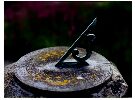
|
|
With this dial we are catching the shadow on a horizontal plate, hence the name horizontal dial. The gnomon is parallel with the Earth's axis and so it is pointing due North. To illustrate the catching of the shadow I have resorted to 'Blue Peter' technology to produce this series of slides.
This is the gnomon. It stands in space at the correct angle.
|

|
|
Now we slip in a horizontal surface SLIDE 5 to catch the shadow and measure what it means with time lines.
|

|
|
Next we have a vertical flat surface SLIDE 6 stuck to the horizontal dial. This shows the relationship between a horizontal dial and a vertical dial. The gnomon is at the same angle in space but when measured against the vertical dial the angle is 90ominus latitude, or the complement of the latitude.
|

|
|
Lastly here is the vertical dial by itself SLIDE 7.
Here then is one reason why our sundial might make a bad job of time keeping. The gnomon may be at the wrong angle. This is almost always the case with garden centre sundials. Sadly some serious sundials have been restored with aesthetics rather than accuracy given priority so the dial shows the incorrect time on an apparently capricious basis. It is possible to do something about this but that is outside my brief for today.
|
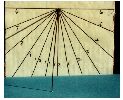
|
|
The lines which mark the time can be derived in several ways and it is fairly simple to calculate them for a horizontal dial or a vertical dial facing south, like this example. SLIDE 6
Note that the hour lines are symmetrical for morning and afternoon. Also note that the noon line points due north/south on the horizontal and straight down on the vertical.
The 6am and 6pm lines are due east/west on the horizontal and here on the vertical they are horizontal. These lines are always in those places but the ones in between are at angles calculated by reference to the latitude.
|

|
I am therefore able to check from these lines, even if there is no gnomon, whether a dial was made for a particular place.
Time before 6am or after 6pm is not recorded on a south facing vertical dial.
Some Jersey Sundials
|
Let us have a look at some of the dials here in Jersey.
This is the dial at Hamptonne, which will be familiar to many of you. SLIDE 9
The dial was found to be cemented to the central chimneystack when restoration of Hamptonne was started in the late 1980s. It was removed, cleaned, a gnomon added and then it was reinstalled above the new porch.
It is probably one of our oldest sundials, which is why I am showing it now. It is good that it can now be easily seen.
|
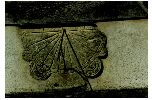
|
It is not a particularly good timekeeper and in view of its age we can blame the original constructor but it is possible that the reaffixing may have contributed to the problem.
The date 1640 ties in with the Hamptonne story.
This is a South facing vertical dial with symmetrical markings and horizontal six o'clock lines.
|
To keep the Hamptonne dial company here is its brother.
This is he dial at St Lawrence Church.
It is very similar to the Hampton dial and it also has Roman hour numbers and a little cross. The cross does not seem unusual on a church dial here but I wonder why there is a cross on the one at Hamptonne. SLIDE 9 then back to SLIDE 10. Perhaps someone made use of a redundant church dial at Hamptonne.
|
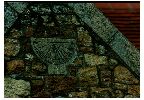
|
It is hard to put a date on the dial but it could be a few decades earlier or later than 1640.
The dial lay, for many years, in the storerooms of the Société from 1933 when it was donated by Mr A E Le Blancq. We are not sure how he acquired it but it appears to have come to light when St Lawrence Church was refurbished in the 1890s.
Mr A S Pipon, who has provided me with some very useful background information on the sundial, applied to the Société in 1977 for the return of the dial. It was installed in June 1978 and rededicated in a service in January 1979.
There used to be a brass plaque in the Church explaining the reinstallation of the dial but, sadly, this was removed during redecoration and has not been replaced.
|
Here is a very sad looking dial at Le Coin Farm in St Brelade.
This one does not even have numbers and it is extremely difficult to date.
|
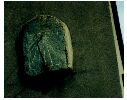
|
|
This other view illustrates an interesting point.
The east side is built up away from the rendered chimney so that the face of the dial correctly points due south. If this had not been done the dial could not have been accurate.
So now we have another reason for bad timekeeping: failure to align the dial correctly. It is statistically improbable that any given wall will face due south and almost all south-facing vertical dials that have been correctly set up allow for this with padding on one side or the other.
In this example the gnomon has almost rusted away and, at some time, wire has been used to reinforce it. I hope to be involved with some conservation work on the dial and one day it should keep a proper record of the hours.
|

|
|
Another sorry looking sundial where heroic efforts have been made to keep the dial facing south.
The dial is on the Church of St Peter and is just visible from the Co-op car park.
|
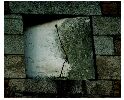
|
|
The stone of the dial seems to be sound, if a little dirty, but the iron gnomon, which was fairly ornate, has almost rusted away, as shown in this slide.
|
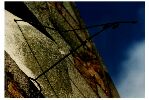
|
|
One last example of a dial set at an angle to the wall. It is at St Cyr, St John.
This dial was made in 1977 to fill the ugly looking wedge that was left when the original, dated 1819, had been removed.
It is refreshing that the long tradition of sundials was still being supported as recently as 25 years ago.
I have spoken to the lady who arranged for the sundial to be made but she has little recollection of the details of the operation.
The original sundial disappeared many years ago and has either been set up somewhere else or simply fell apart. If anyone knows of a south-facing dial, inscribed 1819 E Le G, I should be very interested to see it.
|


|
It is not satisfactory to have sundials projecting from walls and there is a solution. The shadow, which is caught on a horizontal or vertical dial, can be caught on any suitable surface. The dial can therefore lay flat against a wall to catch the shadow. If this is done the time lines are no longer symmetrical.
|
Here is a good example of such a dial.
As you will all recognise it is the dial in the Royal Square. The second picture shows the dial in the late 1920s and early 1930s. There is no significant change.
This is an example of a declining dial. The spaces between the hour lines are greater on the morning side, your left, than for the afternoon. The gnomon is still pointing at the same angle in space but, as the wall has deviated from the east west line, the base of the gnomon (if there had been one) would run along the 1:30pm line instead of the noon line.
A Jerseyman called Elias Le Gros made the dial, in the 1820s. It is probably a coincidence that the previous dial, at St Cyr, bore his initials. He was a mathematician, tutor of navigation, civil engineer, cartographer and inventor. The old newspapers are scattered with references to his exploits.
For example in 1834 he was awarded £200 to make engravings of his map of St Helier.
|


|
Sadly in 1859 the last reference appeared in a report that he had been found of unsound mind by the Royal Court and committed to the Hospital. In attempting to escape over the wall he broke his ankle and was consigned to the infirmary. That is the last we hear of him. He must have died, either then or sometime later, but no one has traced when. Neither is there any record of where he was buried.
In 1875 the Chronique de Jersey, in an editorial, demanded the restoration of what they called the Quadrant in the Royal Square. There had been a dispute between the Military and Civil Authorities over the tenancy of the Picket House. For many years the civilian tenant had kept the dial clean and freshly painted. When the Military took possession they obliterated the dial with plaster and paint. A direct appeal was made to the Lt Governor to have the Quadrant restored immediately.
Sure enough, just thirteen years later, the Chronique was able to report that the sundial, Le Cadran Solaire rather than le Quadrant, was almost fully restored. Mr Carter, the monumental mason, re-carved the lines and text that had been filled with cement.
Here in the heart of St Helier we have a fine monument to an exceptionally talented Jerseyman who has no other memorial. It is, in my view, rather sad that there are two plaques, with conflicting information, on the wall of the Picket House and neither of them mentions poor old Elias Le Gros.
|
There is another feature of this sundial that is worth a mention.
This shows a close up of the inscription below the dial.
REGULATE YOUR CLOCKS BY THE SUN DIAL
CORRECTION MUST BE MADE
FOR THE EQUATION OF TIME
WHICH IS GIVEN IN ALL THE ALMANACKS
|
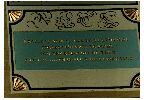
|
What does this mean? I have come across one or two suggestions but I think it would be best if I gave you the correct answer.
The Sun is a pretty poor timekeeper when compared with a clock, or the stars. If you measure a day from when the sun is due south, which is sundial noon, to the next time it is sundial noon you find that it did not take exactly 24 hours. From noon yesterday, 28 November, to noon today was an interval of 24 hours and 21 seconds. The period from noon today until tomorrow is also 21 seconds over the 24 hours.
On this basis the sun gets out of step with clocks and watches. I am not going to go into the detail of why this happens, except to say that the orbit of the Earth is an ellipse and the axis of the Earth is tilted. From this astronomers in the 17th century led by John Flamstead, the Astronomer Royal, worked out how far the sun is adrift from mechanical clocks and the stars. It was around this time that long pendulum clocks with sufficient accuracy to test Flamstead's tables were first being produced by such makers as Thomas Tompian.
For rustic timekeeping a sundial to back up an innate sense of time, which most people possess, was sufficient. But with the increased use of mechanical clocks events were synchronised with clock time, which has precisely 24 hours in a day. This is the average, or mean, length of a sundial day: if you add up all the days in the year. Clock time was therefore called meantime or Temps Moyen.
|
If you looked in an almanac for today, and I mean a proper almanac that gives astronomical information, you would see that you have to take 11 minutes and 38 seconds off the sundial time to get local meantime. This would have been a very familiar operation to educated people, from the end of the seventeenth century to the early twentieth, who needed to regulate their household clocks. The last time that tables for Temps Moyen were published locally was in the 1100
6 edition of the Almanac de la Chronique.
This graph shows the Equation of time throughout the year. Here you have to add to the time on the sundial and here you deduct in order to get Jersey meantime.
|
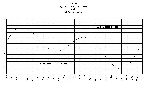
|
We have now identified yet another reason for the sundial to make a botch of timekeeping.
That is not the end of the adjustments that are needed unfortunately. Everyone is familiar with the fact that because the world is round the sun tells a different time at different places. To put some numbers into the story, there are 360 degrees of longitude that are crossed by the sun in 24 hours. This means that the sun goes through 15 degrees in one hour or one degree of longitude gives 4 minutes of time difference. This is one of the foundations of navigation at sea. Tell the time by the sun, allow for the Equation of time, and note the difference from the time in your home port by reference to a chronometer. Even in a place as small as Jersey there is a difference in sundial time of nearly one minute from one side of the Island to the other. Fortunately most sundials are physically incapable of distinguishing a single minute so that should not cause a problem.
Although everyone used meantime each community used its own local meantime. Navigators standardised on the major observatories, such as Greenwich or Paris. Railways and the electric telegraph required standardisation.
|
In 1880 GMT was introduced into the United Kingdom. In 1884 it was adopted by the whole world as the basis for all the time zones. It was not until 11 June 1898 that Jersey fell into line and started to use GMT. The States in those days could not be described as hasty.
For just over a hundred years we have needed to add about 8 minutes, for the 2 degrees of longitude, to sundial time as well as allowing for the Equation of Time. I have combined the two in this graph. SLIDE 19 This shows what you need to add to or deduct from sun time to get clock time. When applied to our better dials they are spot on. Every sundial owner should have one of these, perhaps engraved on a little plaque.
|
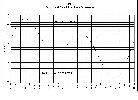
|
The only other thing to bear in mind is British Summer Time. This adds an hour to the corrected sundial from March to October, when we are most likely to be outside looking at it. People adjust their garden sundials by rotating them when the clocks change. It is technically possible to make an adjustment but not that way. If you remember I said at the outset that the gnomon must point due north and the angle must be the same as the latitude. When you twist the dial around the gnomon no longer points due north and so it cannot do a proper job telling the time.
The Register of Sundials in Jersey
|
The British Sundial Society SLIDE 20 was founded in 1989 and has about 600 members worldwide. I appear to be the only member in Jersey. One of the objects of the Society is to produce and maintain a register of sundials in the British Isles. So far more than 4000 dials have been recorded.
When I joined the History Section of the Société, about a year ago, I decided to record all the Jersey sundials for the BSS and to provide a duplicate of the register entries for the Société Library.
|

|
My starting point was a typescript catalogue, in the Library, written by Charles Stevens in 1977. This has details of 39 sundials, many of which had vanished by that time.
Members of the History Section have suggested where I might find dials and I hope that some of you may be able to assist by identifying more samples for me to catalogue. On the table I have left a couple of progress lists of the dials I know about with some spare paper. After the meeting if you know of a dial not on my list please jot down a note, or take the paper away and get in touch with me later.
That's the end of the commercial, back to the dials! Here are some that I have come across in my research.
|
The oldest bit of sundial that we know of in Jersey SLIDE 21 is this bit of slate which lives in a glass case at Mont Orgueil. The date 1556 is scratched on it, as well as the three daggers to represent the Poulet family and presumably they refer to Sir Hugh Poulet. This is not in the Register as the policy is not to record items lodged in museums, but I thought you would like to see it.
|
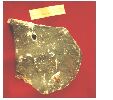
|
|
This is my first dial SLIDE 22 at St Brelade's Church. It had already been recorded by BSS members visiting the Island but I have been able to add to the previous information.
|
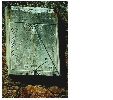
|
|
The exotic markings SLIDE 23 are an attempt by the designer, in 1837, to allow for the Equation of Time or, as it was then known Tems Moyen. I have concluded that the designer of the dial made a number of mistakes. I do not have time to go into the details but I have submitted a paper, which is to be published in the December BSS Bulletin, and a copy will be made available to the History Section and the Library.
|
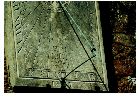
|
|
The motto, which is not easy to read, SLIDE 24 is taken from Psalm 144 verse 4 in the French translation of the Book of Common Prayer:
L'HOMME EST SEMBLABLE À LA VANITÉ, SES JOURS SONT COMME UNE OMBRE QUE PASSE
|
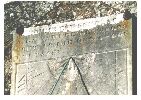
|
|
Here is another look at a dial we saw earlier. SLIDE 3
It is a horizontal dial in the gardens of Samarès Manor and I took the picture a couple of years ago. This is what it looked like at the end of June this year. SLIDE 26 When I spoke to Vincent Obbard about the apparent damage he reassured me that it was only a replica made of roofing slates, some 20 years ago, when the original had become too eroded to read. Sadly the remains of the old dial plate, which was perhaps two hundred years old, were discarded.
|

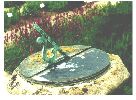
|
|
If you think two hundred years is a long time my next dial SLIDE 27 may be over 800 years old.
This bit of granite is thought to be a Mass Dial, which would have been used to regulate the times of worship in one of the many chapels or chantries that existed in the Island in the 12th century.
It is certainly a very old piece of stone but it is not quite like the normal form of mass dials, which are fairly common in the UK and France. Until we have more information, the identification is undecided.
|

|
|
This is what the dial may have looked like, when in use.
More information might be forthcoming when other dialists see the next Bulletin as I have also mentioned this one in my article.
|
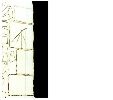
|
|
Many of you will know this one SLIDE 29 Sycamore Cottage in St Aubin.
A south facing dial with evidence of paint
The surface of the slate is starting to break up, which is not surprising after more than 200 years.
The paint is almost certainly not the original colour but there may have been a continuity of decoration.
|
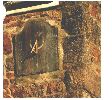
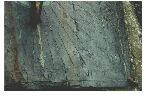
|
|
Another dial that would have been coloured originally SLIDE 31 . Mont à L'Abbé Manor is being restored and I was able to get quite close to the sundial.
It is a declining dial which means that the designer drew the lines to suit this side of this particular chimney.
There is a blank space in the centre of the dial. You cannot see the detail and I was only able to make out some of it. It seems to me that the hour lines were made deep and bold, to be visible from afar but the numbers and the decorations were scratched as a guide for the painter.
|
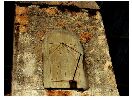
|
|
I hope to get even closer to the dial when scaffolding is placed around the chimney.
This is a close relation of the Mont à L'Abbé dial SLIDE 32. It is from Le Bel Royal and is no longer attached to a wall.
The workmanship and style is very similar to the previous example. This one is dated 1792, which must be a clue for setting a date for Mont à L'Abbé.
This too is a declining dial, purpose made for a particular site.
|
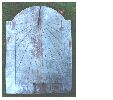
|
|
Even from a few inches away the scratched designs are not clear and I am sure the dial would originally have been brightly painted.
This is my last dial SLIDE 33 and I have included it not because it is historic or ancient, it is simple a very beautiful dial.
It is on the wall at Eulah House on Mont Cochon and was made, as part of the design of the house in about 1906.
It is a circular declining dial made of slate and partly gilded.
|
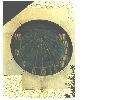
|
|
Here is a close-up SLIDE 34 . The material between the hour lines is gently contoured, as a piece of sculpture. Everything about the dial is in harmony and, as can be seen from this view of the front of the house SLIDE 35 the positioning of the sundial is in just the right spot. This is the only sundial in Jersey, that I know of, that was almost certainly included as an integral part of the architectural design of the property.
This dial was made less than 100 years ago. There is no reason why a similar approach should not be taken today. We boast of being the Sunshine Island. What better way to celebrate this than with well designed sundials on our prominent buildings and public places?
|
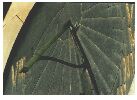
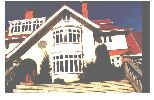
|
|



































